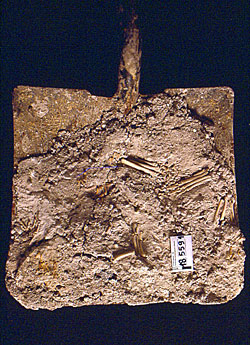- Home
- Crafts and daily life
- The medieval town and its crafts
- A furrier's workshop from the 12th century
Sample of animal paws, still anatomically connected, last quarter of the 12th century.
© UASD / E. Jacquot.
The presence of a tanning pit has revealed the existence of a furrier's workshop that was active during the last quarter of the twelfth century. The pit was built to hold water, and its use resulted in the layer of silt found at the bottom, interspersed with thin strata of plaster or white lime, and ash. The silt layer also revealed several hundred animal paws that were still in anatomical connection-these very likely correspond to waste produced during the tanning process.
Furriers specialized in the treatment of pelts of small animals. To judge by the dimensions of the paws, domestic species prevailed: cats represent three-fourths of the total, but rabbits were still in the minority, because this animal-very prized for its fur-had only just been introduced in the region. Wild species included the fox and the squirrel.

